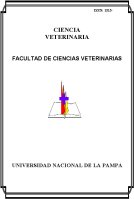Ultrastructure of the pig placenta at the different periods of gestation
Keywords:
Placenta, SwineAbstract
Placenta for eight sows, 3 in early pregnancy (28 days), 2 in the middle third of gestation (69 days) and 3 at term pregnancy (112 days) were examined by optic microscopy and transmission electron microscopy. The swine placenta, key organ for the success of the pregnancy, is characterised to be diffuse and epitheliochorial. In uterine luminal endometrium attachment of trophoblast fetal with maternal epithelium were observed. In this maternofetal interface of placenta the 28 days pregnancy the spaces between cell and cell were observed; these spaces could be central form of alimentation histiotrophe in this gestational period. The uterine cells contain electron-dense granules connected by narrow cisterns. At the 69-day stage of gestation the epithelial cells have more cell activity because they have nucleolo for cell and this is characteristic of cell division. The maternofetal interface of the placenta at the 69-day stage of gestation is more developed that maternofetal interface at the 28 days of gestation. Placenta at term show trofoblastic cells where it was observed many secretion of proteins and process characteristics of the apoptosis. The knowledge of the architecture and development of the placental areas through the different gestational periods, will allow to understand the immunoendocrine phenomenon that sustains the swine gestation. In this work, ultrastructural placental morphology from different periods of gestation was comparedDownloads
Downloads
Published
How to Cite
Issue
Section
License
Al momento de enviar sus contribuciones, los colaboradores deberán declarar , de manera fehaciente, que poseen el permiso del archivo o repositorio donde se obtuvieron los documentos que se anexan al trabajo, cualquiera sea su formato (manuscritos inéditos, imágenes, archivos audiovisuales, etc.), permiso que los autoriza a publicarlos y reproducirlos, liberando a la revista y sus editores de toda responsabilidad o reclamo de terceros , los autores deben adherir a la licencia Creative Commons denominada “Atribución - No Comercial CC BY-NC-SA”, mediante la cual el autor permite copiar, reproducir, distribuir, comunicar públicamente la obra y generar obras derivadas, siempre y cuando se cite y reconozca al autor original. No se permite, sin embargo, utilizar la obra con fines comerciales.



4.png)


7.png)



